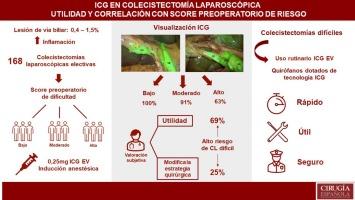腹腔镜胆囊切除术中的吲哚菁绿:实用性以及与术前风险评分的相关性
IF 1.3
4区 医学
Q3 SURGERY
引用次数: 0
摘要
背景本研究旨在比较根据择期腹腔镜胆囊切除术难度划分的三组患者用吲哚菁绿(ICG)观察胆囊管-胆总管交界处的情况。方法这项非随机、前瞻性、观察性研究在一个中心进行,共纳入了 168 名接受择期腹腔镜胆囊切除术的患者,并通过术前风险评分进行评估,以预测胆囊切除术的难度,包括临床因素和放射学检查结果。结果确定了三个组别:低风险组、中度风险组和高度风险组。结果低、中、高风险组分别有28例(100%)、113例(91.1%)和10例(63%)患者实现了胆囊管-胆总管交界处的可视化。高风险组的总手术时间更长,转化率更高,并发症更多,住院时间更长。根据外科医生的主观评估,低风险组中有 36% 的患者认为 ICG 有用,中度风险组中有 58% 的患者认为 ICG 有用,高风险组中有 69% 的患者认为 ICG 有用。此外,ICG 在低风险组中没有改变外科医生手术方法的病例,而在中度风险组和高风险组中分别为 11% 和 25%(p <0.01)。结论这项研究的结果证实,在困难胆囊切除术中,63% 的病例能看到胆囊管-胆总管交界处,每四名患者中就有一人需要改变手术方法。本文章由计算机程序翻译,如有差异,请以英文原文为准。

Verde de indocianina en la colecistectomía laparoscópica: utilidad y correlación con un score preoperatorio de riesgo
Background
This study aims to compare the visualization of the cystic duct-common bile duct junction with indocyanine green (ICG) among 3 groups of patients divided according to the difficulty of elective laparoscopic cholecystectomy.
Methods
Conducted at a single center, this non-randomized, prospective, observational study encompassed 168 patients who underwent elective laparoscopic cholecystectomy and were assessed with a preoperative risk score to predict difficult cholecystectomies, including clinical factors and radiological findings. Three groups were identified: low, moderate, and high risk. A dose of 0.25 mg of IV ICG was administered during anesthesia induction and the different objectives were evaluated.
Results
The visualization of the cystic duct-common bile duct junction was achieved in 28 (100%), 113 (91.1%), and 10 (63%) patients in the low, moderate, and high-risk groups, respectively. The high-risk group had longer total operative time, higher conversion, more complications and longer hospital stay. In the surgeon's subjective assessment, ICG was considered useful in 36% of the low-risk group, 58% in the moderate-risk group, and 69% in the high-risk group. Additionally, there were no cases where ICG modified the surgeon's surgical approach in the low-risk group, compared to 11% in the moderate-risk group and 25% in the high-risk group (p < 0.01).
Conclusions
The results of this study confirm that in the case of difficult cholecystectomies, the visualization of the cystic duct-common bile duct junction is achieved in 63% of cases and prompts a modification of the surgical procedure in one out of four patients.
求助全文
通过发布文献求助,成功后即可免费获取论文全文。
去求助
来源期刊

Cirugia Espanola
SURGERY-
CiteScore
1.20
自引率
21.10%
发文量
173
审稿时长
53 days
期刊介绍:
Cirugía Española, an official body of the Asociación Española de Cirujanos (Spanish Association of Surgeons), will consider original articles, reviews, editorials, special articles, scientific letters, letters to the editor, and medical images for publication; all of these will be submitted to an anonymous external peer review process. There is also the possibility of accepting book reviews of recent publications related to General and Digestive Surgery.
 求助内容:
求助内容: 应助结果提醒方式:
应助结果提醒方式:


